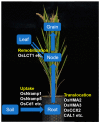Advances in the Uptake and Transport Mechanisms and QTLs Mapping of Cadmium in Rice
- PMID: 31336794
- PMCID: PMC6678204
- DOI: 10.3390/ijms20143417
Advances in the Uptake and Transport Mechanisms and QTLs Mapping of Cadmium in Rice
Abstract
Cadmium (Cd), as a heavy metal, presents substantial biological toxicity and has harmful effects on human health. To lower the ingress levels of human Cd, it is necessary for Cd content in food crops to be reduced, which is of considerable significance for ensuring food safety. This review will summarize the genetic traits of Cd accumulation in rice and examine the mechanism of Cd uptake and translocation in rice. The status of genes related to Cd stress and Cd accumulation in rice in recent years will be summarized, and the genes related to Cd accumulation in rice will be classified according to their functions. In addition, an overview of quantitative trait loci (QTLs) mapping populations in rice will be introduced, aiming to provide a theoretical reference for the breeding of rice varieties with low Cd accumulation. Finally, existing problems and prospects will be put forward.
Keywords: QTL location; absorption and transport; cadmium accumulation; mapping population; rice (Oryza sativa L.).
Conflict of interest statement
The authors declare no conflict of interest.
Figures


Similar articles
-
QTL mapping and candidate gene analysis of cadmium accumulation in polished rice by genome-wide association study.Sci Rep. 2020 Jul 16;10(1):11791. doi: 10.1038/s41598-020-68742-4. Sci Rep. 2020. PMID: 32678216 Free PMC article.
-
Quantitative trait loci mapping for cadmium and microelements accumulation in rice using recombinant inbred lines.Plant Physiol Biochem. 2025 Jul;224:109933. doi: 10.1016/j.plaphy.2025.109933. Epub 2025 Apr 16. Plant Physiol Biochem. 2025. PMID: 40253916
-
Genetic properties of cadmium translocation from straw to brown rice in low-grain cadmium rice (Oryza sativa L.) line.Ecotoxicol Environ Saf. 2019 Oct 30;182:109422. doi: 10.1016/j.ecoenv.2019.109422. Epub 2019 Jul 10. Ecotoxicol Environ Saf. 2019. PMID: 31301594
-
Advances in molecular mechanisms underlying cadmium uptake and translocation in rice.Front Plant Sci. 2022 Sep 20;13:1003953. doi: 10.3389/fpls.2022.1003953. eCollection 2022. Front Plant Sci. 2022. PMID: 36204081 Free PMC article. Review.
-
The role of QTLs in the breeding of high-yielding rice.Trends Plant Sci. 2011 Jun;16(6):319-26. doi: 10.1016/j.tplants.2011.02.009. Epub 2011 Mar 21. Trends Plant Sci. 2011. PMID: 21429786 Review.
Cited by
-
Genetic Databases and Gene Editing Tools for Enhancing Crop Resistance against Abiotic Stress.Biology (Basel). 2023 Nov 3;12(11):1400. doi: 10.3390/biology12111400. Biology (Basel). 2023. PMID: 37997999 Free PMC article. Review.
-
The Rice Cation/H+ Exchanger Family Involved in Cd Tolerance and Transport.Int J Mol Sci. 2021 Jul 30;22(15):8186. doi: 10.3390/ijms22158186. Int J Mol Sci. 2021. PMID: 34360953 Free PMC article.
-
Heavy Metal Transporters-Associated Proteins in S. tuberosum: Genome-Wide Identification, Comprehensive Gene Feature, Evolution and Expression Analysis.Genes (Basel). 2020 Oct 28;11(11):1269. doi: 10.3390/genes11111269. Genes (Basel). 2020. PMID: 33126505 Free PMC article.
-
The Effect of Rhizophagus intraradices on Cadmium Uptake and OsNRAMP5 Gene Expression in Rice.Int J Mol Sci. 2025 Feb 10;26(4):1464. doi: 10.3390/ijms26041464. Int J Mol Sci. 2025. PMID: 40003930 Free PMC article.
-
Loci and natural alleles for cadmium-mediated growth responses revealed by a genome wide association study and transcriptome analysis in rice.BMC Plant Biol. 2021 Aug 13;21(1):374. doi: 10.1186/s12870-021-03145-9. BMC Plant Biol. 2021. PMID: 34388987 Free PMC article.
References
-
- He S.Y., He Z.L., Yang X.E., Stoffella P.J., Baligar V.C. Soil biogeochemistry, plant physiology, and phytoremediation of cadmium-contaminated soils. Adv. Agron. 2015;134:135–225.
-
- Song W.E., Chen S.B., Liu J.F., Chen L., Song N.N., Li N., Liu B. Variation of Cd concentration in various rice cultivars and derivation of cadmium toxicity thresholds for paddy soil by species-sensitivity distribution. J. Integr. Agric. 2015;14:1845–1854. doi: 10.1016/S2095-3119(14)60926-6. - DOI
-
- Liu F., Liu X.N., Ding C., Wu L. The dynamic simulation of rice growth parameters under cadmium stress with the assimilation of multi-period spectral indices and crop model. Field Crop. Res. 2015;183:225–234. doi: 10.1016/j.fcr.2015.08.004. - DOI
Publication types
MeSH terms
Substances
LinkOut - more resources
Full Text Sources

